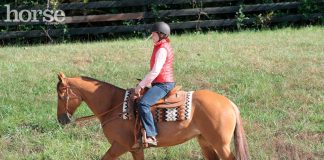Q: I’m having trouble teaching my horse to sidestep. He starts turning instead of walking sideways. How can I correct this?

There are a few basic rein aids you need to understand in order to execute a correct sidepass. The first is an opening rein: Simply move your rein hand 4 to 8 inches sideways, away from your horse’s neck. Be careful not to move your hand forward toward your horse’s mouth or pull back toward your hip.
The other rein aid is the direct rein, pulling the rein back toward your hip. This will usually shift your horse’s weight slightly over his hocks or cause him to turn. Using too much direct rein is usually the culprit when horses turn instead of moving laterally when asked to sidepass.
To ask for a sidepass to the right, set your horse up so he’s standing still, straight and square. If he has difficulty standing still, try asking for the sidepass near the middle or end of your training session when perhaps he is happy to rest a bit, or practice it another time when he is more attentive and receptive. Begin with a light contact on the reins, then open your right rein 4 to 8 inches away from your horse’s neck and apply weight to your left seatbone, while lightening your weight on your right seatbone. Finally, apply left leg pressure a few inches behind the girth.
If your horse moves forward instead of moving to the right, ask again by softly squeezing both reins in your hands while keeping your right rein open and applying the same even pressure with your left leg.
If your horse moves backward, soften your contact slightly and squeeze both of your calves against his barrel gently, equally and at the same time, applying only enough pressure to slow and stop the backing while keeping your right rein open.
If your horse begins turning left, soften your left rein slightly and squeeze your right rein while keeping it open, and vice versa if he turns to the right.
If your horse only moves his forehand, slide your left leg back along his barrel toward his flank and apply slight, steady pressure to move his hips over. The better he moves off your leg pressure, the nicer and cleaner your sidepass will be. Always remember to be gentle and patient.
A great way to help your horse succeed with his sidepass is to practice leg-yielding at the walk. Be sure to work both sides of your horse, keeping in mind that one side will be easier for him than the other. You might need to work the more difficult side more frequently.
TERESA KACKERT is an AQHA Professional Horseman and a Certified Horsemanship Association (CHA) Clinic Instructor and Equine Facility Manager. The CHA certifies instructors and trail guides, accredits equestrian facilities, publishes educational manuals, produces educational horsemanship DVDs, and hosts regional and international conferences. For more information on the CHA, visit www.cha-ahse.org or call 859-259-3399. To find a certified horseback riding instructor or accredited equine facility near you, visit www.chainstructors.com.
This article originally appeared in the October 2013 issue of Horse Illustrated. Click here to subscribe!






I hope I can remember all of this when I practice. Good article, but I am sure I will have to reread a few times, to get the idea into my head.
Sounds complicated.